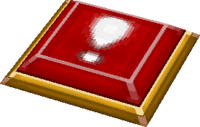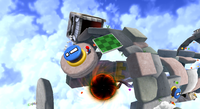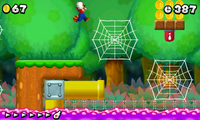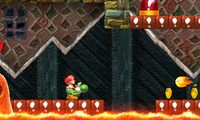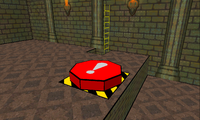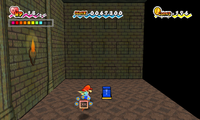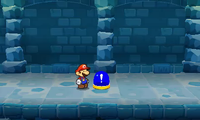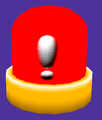! Switch: Difference between revisions
(plenty of images) |
|||
| (313 intermediate revisions by 82 users not shown) | |||
| Line 1: | Line 1: | ||
{{item infobox | |||
{{item | |image=[[File:YIDS Redswitch.jpg|200px]]<br>Artwork from ''[[Yoshi's Island DS]]'' | ||
|image=[[File:YIDS Redswitch.jpg|200px]]<br> | |first_appearance=''[[Super Mario World]]'' ([[List of games by date#1990|1990]]) | ||
|latest_appearance=''[[Paper Mario: The Thousand-Year Door (Nintendo Switch)|Paper Mario: The Thousand-Year Door]]'' ([[Nintendo Switch]]) ([[List of games by date#2024|2024]]) | |||
|first_appearance=''[[Super Mario World]]'' ([[List of | |effect=Triggers an effect to change the stage in some way | ||
|latest_appearance=''[[ | |variants=[[Blue switch (Super Mario Galaxy)|Blue switch]]<br>[[Cap Switch]]<br>[[Large ! Switch]] | ||
|effect=Triggers an effect to change the stage in some way | |related=[[? Switch]]<br>[[P Switch]]<br>[[Skull switch]] | ||
|comparable=[[Axe]] | |||
}} | }} | ||
A '''! Switch'''<ref>{{cite|author=Bueno, Fernando|date=November 15, 2009|title=''New Super Mario Bros. Wii: PRIMA Official Game Guide''|publisher=[[Prima Games]]|language=en-us|isbn=978-0-307-46592-4|page=67 and 171}}</ref><ref>{{cite|author=von Esmarch, Nick|date=2012|title=''New Super Mario Bros. 2'' PRIMA Official Game Guide|publisher=Prima Games|language=en-us|isbn=978-0-307-89552-3|page=86, 87, 142, 168, 228}}</ref><ref>{{cite|author=Stratton, Steve|title=''New Super Mario Bros. U'' PRIMA Official Game Guide|page=201|date=November 18, 2012|language=en-us|publisher=Prima Games|isbn=978-0-307-89690-2}}</ref> (or '''!-Switch'''),<ref>{{cite|author=Hodgson, David S J|date=October 21, 2003|title=''Super Mario Advance 4: Super Mario Bros. 3'' Prima's Official Strategy Guide|publisher=Prima Games|language=en-us|isbn=0-7615-4425-8|page=122}}</ref> also known as a '''! Switch Block'''<ref>{{cite|date=2012|url=cdn02.nintendo-europe.com/media/downloads/games_8/emanuals/nintendo_ds_21/Manual_NintendoDS_NewSuperMarioBros_EN.pdf|title=''New Super Mario Bros.'' European instruction booklet|format=PDF|publisher=Nintendo of Europe|language=en-gb|page=18}}</ref> or simply a '''switch''', is a type of [[Switch Block (disambiguation)|Switch Block]] first seen in ''[[Super Mario World]]''. ! Switches usually either turn [[block]]s solid or affect the environment in some capacity. | |||
==History== | |||
== | |||
===''Super Mario'' series=== | ===''Super Mario'' series=== | ||
====''Super Mario World''==== | ====''Super Mario World'' / ''Super Mario World: Super Mario Advance 2''==== | ||
[[File:SMWswitches.png|frame|left|The four | [[File:SMWswitches.png|frame|left|The four big switches from ''Super Mario World'']] | ||
Each of the four [[Switch Palace]]s in ''Super Mario World'' and [[Super Mario World: Super Mario Advance 2|its reissue]] features a differently colored ! Switch (simply referred to as a "'''big switch'''" in the manual<ref>{{cite|title=''Super Mario World'' English instruction booklet|page=21}}</ref> and also known as a '''Switch'''<ref>{{cite|date=September 1991|title=''Nintendo Power'' Volume 28|page=14 and 22|publisher=Nintendo of America|language=en-us}}</ref>) of a different color, in the order of '''Yellow Switch''',<ref name=mania>{{cite|date=August 1991|title=''[[Mario Mania]]'' Player's Guide|publisher=Nintendo of America|language=en-us}}</ref>{{ref page|56}} the '''Green Switch''',<ref name=mania/>{{ref page|67}} the '''Red Switch''',<ref name=mania/>{{ref page|82}} or the '''Blue Switch'''.<ref name=mania/>{{ref page|108}} They turn every [[Dotted-Line Block]] of the same color into an [[! Block|Exclamation Mark Block]]. Pressing {{button|snes|B}} in the original ''Super Mario World'' the instant a switch is pressed keeps them in midair while a message is displayed for activating it.<ref>{{cite|date=February 12, 2022|url=smwspeedruns.com/Yump|title=Yump|publisher=Super Mario World Speedrunning Wiki|accessdate=July 17, 2023|archive=web.archive.org/web/20230717232545/https://smwspeedruns.com/Yump}}</ref> | |||
{{br}} | {{br}} | ||
====''Super Mario 64''==== | ====''Super Mario 64'' / ''Super Mario 64 DS''==== | ||
[[File: | [[File:SM64 Purple Switch.png|thumb|left|A Purple Switch from ''Super Mario 64'']] | ||
[[File:NSMB Unused Purple Switch.png|thumb|A Switch from ''Super Mario 64 DS'']] | |||
''[[Super Mario 64]]'' features two types of ! Switches. '''Purple Switches'''<ref>{{cite|date=1996|title=''Super Mario 64'' Player's Guide|publisher=Nintendo of America|language=en-us|page=18}}</ref> (or '''Purple Exclamation Switches''')<ref>{{cite|deadlink=y|language=en-us|archive=web.archive.org/web/19980224211156/http://www.nintendo.com/n64/super_mario64/bowser1.html|title="Bowser in the Dark World" ''Nintendo: Super Mario 64 Strategy|publisher=nintendo.com|accessdate=March 15, 2022}}</ref> appear in most courses and are flat and rectangular in shape, being colored plum in ''Super Mario 64'' and later dark red in ''[[Super Mario 64 DS]]''. Purple Switches usually cause either breakable platforms to appear or make it possible to bypass terrain. A Purple Switch makes a ticking sound indicating its effects and sounds increasingly fast until the effects expire. The original version also has three [[Cap Switch]]es, which are shaped like ! Switches in the previous game and similarly make a certain type of block usable, [[Cap Block]]s. ''Super Mario 64 DS'' integrates the functions of the three ! Switches into one red [[? Switch]] and adds another variation, the [[Star Switch]]. | |||
====''Super Mario Advance 4: Super Mario Bros. 3''==== | |||
Small yellow !-Switches are in three [[World-e]] levels of ''[[Super Mario Advance 4: Super Mario Bros. 3]]'': [[Doors o' Plenty]], [[A Sky-High Adventure]], and [[Sea to Sky]]. Pressing them turns every Dotted-Line Block into ! Blocks temporarily. They can be carried, similar to [[P Switch|Switch Block]]s, though they can be activated more than once. | |||
====''New Super Mario Bros.''==== | ====''New Super Mario Bros.''==== | ||
[[ | Every ! Switch is red in ''[[New Super Mario Bros.]]'', temporarily making every Dotted-Line Block into a [[Red Block]]. | ||
The Purple Switch from ''Super Mario 64'' exists as an [[List of New Super Mario Bros. pre-release and unused content|unused]] object in the files. | |||
====''Super Mario Galaxy'' / ''Super Mario Galaxy 2''==== | |||
[[File:SMG2 Stone Cyclone Tox Boxes.png|thumb|left|A blue switch in ''Super Mario Galaxy'']] | |||
{{main|Blue switch (Super Mario Galaxy)}} | |||
There are ! Switches titled [[blue switch (Super Mario Galaxy)|blue switch]]es, a type of [[Ground-Pound Switch]] in ''[[Super Mario Galaxy]]'' and ''[[Super Mario Galaxy 2]]'' with a temporary effect indicated by a timer noise. | |||
An [[list of Super Mario Galaxy pre-release and unused content#Unused data|unused model]] of a red checkpoint ! Switch is in the files of ''Super Mario Galaxy''. | |||
====''New Super Mario Bros. Wii''==== | ====''New Super Mario Bros. Wii''==== | ||
[[ | ! Switches appear in ''[[New Super Mario Bros. Wii]]''. Activating one in [[World 3 (New Super Mario Bros. Wii)|World 3]] makes every Red Block usable in [[World 3-4 (New Super Mario Bros. Wii)|World 3-4]] and [[World 3-5 (New Super Mario Bros. Wii)|World 3-5]], though a different one nearby deactivates them. A ! Switch functions in place of an [[axe]] during the final battle with [[Bowser]], causing him to fall, and a [[large ! Switch]] is later into the battle, defeating Bowser completely. | ||
====''New Super Mario Bros. 2''==== | ====''New Super Mario Bros. 2''==== | ||
[[File:NSMB2_World_3-3_Jump.png|thumb | [[File:NSMB2_World_3-3_Jump.png|thumb|A ! Switch upside down on a platform in ''New Super Mario Bros. 2'']] | ||
Red ! Switches are single-use objects in ''[[New Super Mario Bros. 2]]''. They usually cause [[coin]]s to appear, but they do appear in various fights against Bowser, including the final one, [[Dry Bowser]] in [[World Star (New Super Mario Bros. 2)|World Star]], and in the [[Third Course (Gold Classics Pack)|third course]] of the [[Gold Classics Pack]]. | |||
====''New Super Mario Bros. U'' / ''New Super Luigi U'' / ''New Super Mario Bros. Deluxe''==== | |||
The map of [[Rock-Candy Mines]] in ''[[New Super Mario Bros. U]]'' has red and blue switches similar to ! Switches, and one functions in the battle against Bowser the same as in ''New Super Mario Bros. Wii''. | |||
====''Super Mario Run''==== | |||
! Switches are yellow in ''[[Super Mario Run]]'', although Red Blocks are formed from [[Dotted-Line Block]]s temporarily. [[Scuttlebug Forest]] has some ! Switches that cause coins to dangle from strings temporarily. | |||
===='' | ====''Super Mario Bros. Wonder''==== | ||
There is only one ! Switch in ''[[Super Mario Bros. Wonder]]'', found in the second [[10-flower coin]] room of [[The Midway Trial: Hop to It]]. Having a [[Hoppycat]] press the ! Switch causes a line of yellow blocks to form over [[Spike Trap|spikes]] temporarily, then the player character has a chance to get the 10-flower coin. There is also a [[large ! Switch]] under the chin of [[Wonder Bowser]]. | |||
===''Yoshi's Island'' series=== | ===''Yoshi's Island'' series=== | ||
[[File:Leapin' Lava Meltdown.png|thumb|left|A | [[File:Leapin' Lava Meltdown.png|thumb|left|A Switch in ''Yoshi's New Island'']] | ||
[[File:! Switch | [[File:SMW2YI ! Switch.png|frame]] | ||
Switches<ref>{{cite|date=1995|url=www.retrogames.cz/manualy/SNES/Super_Mario_World_2-_Yoshi-s_Island_-_Manual_-_SNS.pdf|title=''Super Mario World 2: Yoshi's Island'' instruction booklet|format=PDF|publisher=Nintendo of America|language=en-us|page=17}}</ref><ref>{{cite|date=2002|url=cdn02.nintendo-europe.com/media/downloads/games_8/emanuals/game_boy_advance_8/Manual_GameBoyAdvance_YoshisIslandSuperMarioAdvance3_EN_DE_FR_ES_IT.pdf|title=''Yoshi's Island: Super Mario Advance 3'' instruction booklet|format=PDF|publisher=Nintendo of Europe|language=en-gb|page=11}}</ref><ref>{{cite|date=2006|url=cdn02.nintendo-europe.com/media/downloads/games_8/emanuals/nintendo_ds_21/Manual_NintendoDS_YoshisIslandDS_EN.pdf|title=''Yoshi's Island DS'' instruction booklet|format=PDF|publisher=Nintendo of Europe|language=en-gb|page=17}}</ref><ref>{{cite|url=www.nintendo.com/consumer/downloads/manual-3DS-yoshis-new-island-en.pdf|title=''Yoshi's New Island'' digital manual|format=PDF|page=13}}</ref> appear in every installment of the [[Yoshi (series)|''Yoshi's Island'' series]]: ''[[Super Mario World 2: Yoshi's Island]]'' (and [[Yoshi's Island: Super Mario Advance 3|its reissue]]), ''[[Yoshi's Island DS]]'', ''[[Yoshi's New Island]]''. Jumping on them causes the [[Dotted-Line Block]]s to transform into red [[! Block]]s. These allow the [[Yoshi (species)|Yoshis]] to cross obstacles such as [[pit]]s and spikes, or reach otherwise inaccessible areas. Pressing these switches also occasionally causes a warp to a bonus area to appear, indicated by a red arrow above it. ''[[Yoshi's Story]]'' instead features the [[? Switch]], which has a similar role to the latter function. | |||
{{br}} | {{br}} | ||
===''Super Mario RPG: Legend of the Seven Stars''=== | |||
'''Green Exclamation Switches'''<ref>{{cite|deadlink=y|archive=web.archive.org/web/19980224200851/http://www.nintendo.com/snes/supermariorpg/star2.html|title=Get the second Star Piece|publisher=Nintendo: Super Mario RPG Strategy|language=en-us|accessdate=September 15, 2016}}</ref> are circular and have a flat top in ''[[Super Mario RPG: Legend of the Seven Stars]]''. One in [[Kero Sewers]] drains the water in the main portion, and [[Belome]] stands on another with more water contained behind a lock. A switch is also found in a house of [[Rose Town]] and activates the stairway to it. [[Booster Tower]] has a switch that opens a path in [[Booster Pass]]. Belome stands on a different switch in [[Belome Temple]], now causing a door to [[Monstro Town]] to be closed. Several switches are in one of [[Dr. Topper]]'s puzzles in [[Bowser's Keep]], where pressing them is required. There is lastly a switch in the [[Factory (Super Mario RPG)|Factory]] that activates a crane to [[Smithy]]'s workshop. | |||
===''Wario Land 4''=== | ===''Wario Land 4''=== | ||
[[File:WL4-Switch. | [[File:WL4-Switch.png|frame|The different colored "!" Buttons in ''[[Wario Land 4]]'']] | ||
Three colored blocks are in ''[[Wario Land 4]]'', and these '''"!" Buttons'''<ref>{{cite|date=2001|title=''Wario Land 4'' instruction booklet|publisher=Nintendo of America|language=en-us|page=26}}</ref> (or '''Exclamation Switches'''<ref>{{cite|date=Fall 2001|title=''[[Nintendo Power Advance]]'' V.3|publisher=Nintendo Power|language=en-us|page=53}}</ref>) similarly solidify when [[Wario]] hits them from below and often appear in [[pink area]]s. | |||
===''Paper Mario'' series=== | ===''Paper Mario'' series=== | ||
====''Paper Mario''==== | ====''Paper Mario''==== | ||
[[File: | [[File:PM Exclaimation Switch Render.png|frame|left]] | ||
In ''[[Paper Mario]]'', | [[File:PM Kooper Fortress Switch.png|thumb|[[Mario]] using [[Kooper]] to hit a switch in [[Koopa Bros. Fortress]]]] | ||
In ''[[Paper Mario]]'', switches trigger various events when hit or jumped on and are often involved in puzzles. The standard dome-shaped switches appear in blue and red. Blue switches can only be used once, normally for opening passages of some kind, while the red switches can be used an unlimited amount of times, and are normally used for moving important objects. | |||
In the prologue, the [[Goomboss|Goomba King]] warns [[Mario]] not to press a blue switch, claiming it is "dangerous". However, Mario presses it, the [[Goomba King's Fortress]] turns into a bridge, and the Goomba King and [[Red & Blue Goomba Bros.|Goomba Bros.]] are thrown away. In Chapter 1, Mario has to use [[Kooper]] to press switches that appear over gaps. In [[Dry Dry Ruins (Paper Mario)|Dry Dry Ruins]], flat, stone, square off-pink colored ones appear in certain rooms and are used to drain sand, or in one case cause stairs to emerge from a wall. Similar switches without the exclamation mark are used to rotate stairways. | |||
In the basement of [[Boo's Mansion]], a giant-sized switch appears, and must be triggered using a [[Ground Pound|Spin Jump]] to make the stairs appear. In Chapter 6, a series of paired stone elevators appear with flat, square switches on top in red, green, and purple and must be navigated to reach the [[Puff Puff Machine]]; these also must be pressed with a Spin Jump. | |||
In Chapter 7, a flat, circular green one nearly identical to the ones in ''Super Mario RPG: Legend of the Seven Stars'', called a '''floor switch''' by [[Goombario]], appears on [[Shiver Mountain]] and is used to raise a platform of icy ground. Additionally, more flat square switches which change color when slammed are used to switch between doors in the [[Crystal Palace]], and Mario needs [[Bombette]] for two round red switches that activate a rotating door in the same area. Finally, Bowser uses another green floor switch to remove the bridge to the [[Power Platform]] once Mario and his team have boarded, triggering the final battle. | |||
{{br}} | {{br}} | ||
====''Paper Mario: The Thousand-Year Door''==== | ====''Paper Mario: The Thousand-Year Door''==== | ||
[[File:Shell Toss Info.png|thumb|[[Shell Toss]] demonstration]] | |||
Switches make appearances in several parts of ''[[Paper Mario: The Thousand-Year Door]]'', appearing as red or blue like the previous, as well as retaining its usual functionality of hitting blue switches once and red switches for an unlimited amount of time. Standard switches in this game are now cube-shaped. On rare occasions, they float in the air as blocks and must be jumped at to activate. | |||
In [[Petal Meadows]], Mario has to hit two blue | In [[Petal Meadows]], Mario has to hit two blue switches with circular insides, called '''tandem switches''' (which appear after retrieving the [[Sun Stone|two Stone]] [[Moon Stone|Keys]] in [[Shhwonk Fortress]]), simultaneously to activate the [[Warp Pipe]] to [[Hooktail Castle]]; he accomplishes this by utilizing [[Koops]]'s hold ability. | ||
There are also black and white | There are also black and white switches found in [[the Great Tree]]. [[Mario]] and company push the black switch to reveal four white switches in the room where Mario found the blue key to free the other [[Puni]]es. Mario has to hit the white switches in this order: Sun, Moon, Puni, and Star to retrieve the [[Super Boots]]. Also in the Great Tree is a light-blue colored flat switch (simply called a "typical switch" by [[Goombella]]) which causes a standard blue switch to move underwater whenever it is depressed. Koops' hold ability again must be used to hit the switch when it comes back out. | ||
A giant '''super switch''' appears outside the juice bar in [[Glitzville]]. Mario needs to perform a Spin Jump on it to activate it, allowing him to reach the roof. More super switches appear in [[Rogueport Underground]], and cause blue pipes to appear when triggered. | |||
Switches with numbers inside appear in the lower floors of the [[Riverside Station]]. Mario and friends have to defeat three [[Goomba]]s guarding them to access them. The left switch has to be hit 3 times, the center switch has to be hit 10 times and the right switch only has to be hit once. Hitting the switches the correct amount of times will make them flash red until the last switch is hit. After all the switches are hit, the switches will vanish, opening a staircase leading Mario and friends to the [[Ultra Boots]], as well as a [[Shine Sprite]]. Goombella cannot tattle these switches. | |||
Seven red switches found in the [[Palace of Shadow]] are the only red switches that can only be used once. They move a wheel allowing [[Mario]] and his friends to get to the [[Shadow Queen]]'s throne room and crypt. From left to right, hitting the first, third, fourth and sixth switches, as noted by the stars underneath the wheel, will activate it. | |||
;Tattles | |||
*"''That's just a normal switch. Stomp on it or whack it to flip the switch.''" | |||
*"''That's a super switch. Do a Spin Jump above it to activate it.''" | |||
*"''That's a Lift Switch. Hit it to ride a Lift Block of the same color.''" | |||
====''Super Paper Mario''==== | ====''Super Paper Mario''==== | ||
[[File:SPM Yold Ruins Big Red Switch.png|thumb| | [[File:SPM Yold Ruins Big Red Switch.png|thumb|left|A giant red switch]] | ||
[[File:SPM Blue Switch.png|thumb|200px|A blue switch]] | |||
Red and blue switches appear in ''[[Super Paper Mario]]'' similarly as before. Floating block versions are uncovered by the [[Pixl]] [[Fleep]]. A standard blue switch can be activated to spawn a giant red switch on the floor of [[Yold Ruins]], causing [[Spiky Tromp]]s to fall into a large pit and opening access to a door. [[Flopside]] similarly has one near a [[Heart Pillar]]. Switches changing between blue and pink appear in [[The Dotwood Tree]], spawning platforms of the same color but removing those of the other color. Four switches in [[Floro Caverns]] change between black, white, blue, and red, and changing them is required to match nearby portraits of [[Floro Sapien]] royalty. | |||
{{br}} | |||
===''Super Mario-kun''=== | |||
[[File:SuperMarioKun !Switch 3.jpg|thumb|left|150px|In one part of ''[[Super Mario-kun]]'', the switch is used to activate blocks so they can fall and defeat the [[Rex]].]] | |||
! Switches appear several times in ''[[Super Mario-kun]]''. In one instance, the switch is used to defeat Rex. In another instance, a Reznor knocks Mario onto a building shaped like the ! Switch. After defeating the Reznor, Mario is shown to be exasperated at a set of invisible blocks, which require a ! Switch to activate. | |||
===''Mario Pinball Land''=== | |||
''[[Mario Pinball Land]]'' includes the '''Red Switch''',<ref name=mpl>{{cite|date=2004|url=www.thegameisafootarcade.com/wp-content/uploads/2017/08/Mario-Pinball-Land-Game-Manual.pdf|title=''Mario Pinball Land'' instruction booklet|format=PDF|publisher=Nintendo of America|language=en-us|page=23}}</ref>{{ref page|23}} found in every level, and the '''Blue Switch''',<ref name=mpl/> appearing in [[Grassy Greens Stage]], the Bob-omb minigame within the blue [[Toad's tent]], and in the boss fight against Bowser. Both types of switches give 3,000 [[point]]s when activated. The Red Switch spawns eight [[Red Coin]]s temporarily, but one can activate it again afterward until Mario gets a [[Power Star|Star]], turning the deactivated switch into a red [[! Block]] with a [[Yoshi's Egg|Special Egg]]. The Blue Switch functions differently by location, including by making the windmill accessible in Grassy Greens Stage, making cannons shoot a Bob-omb if activated while flashing, and dropping [[Thwomp]]s during the Bowser battle temporarily, obstructing him. | |||
===''Mario Party 6''=== | |||
A non-functional green, a yellow, and a red ! Switch are displayed inside of [[Orb hut]]s in ''[[Mario Party 6]]''. | |||
{{br}} | {{br}} | ||
===''Super Princess Peach''=== | ===''Super Princess Peach''=== | ||
Switches are found in the [[Fury Volcano]] stages and certain secret stages in ''[[Super Princess Peach]]''. They can be activated while the [[Rage]] [[vibe]] is in effect. There are orange, floating, block-like switches that can turn on or off, and they appear blue in [[Wavy Beach]]. | |||
==='' | ===''Mario & Luigi: Bowser's Inside Story'' / ''Mario & Luigi: Bowser's Inside Story + Bowser Jr.'s Journey''=== | ||
[[File: | {{multiframe | ||
! Switches | |[[File:MLBIS ! Switch On.png]] [[File:MLBIS ! Switch Off.png]] | ||
|size=244 | |||
}} | |||
There are many ! Switches in ''[[Mario & Luigi: Bowser's Inside Story]]'' and its [[Mario & Luigi: Bowser's Inside Story + Bowser Jr.'s Journey|remake]]. They can only be activated using [[Bowser]]'s [[Body Slam (Mario & Luigi: Bowser's Inside Story)|Body Slam]] attack. ! Switches are pink (red in the remake) and transparent but otherwise use their design from ''Super Mario 64''. ! Switches have various effects, like opening doors or spawning platforms, then they become grayed, meaning they are no longer usable. | |||
==='' | ===''Yoshi's Woolly World'' / ''Poochy & Yoshi's Woolly World''=== | ||
Red and yellow ! Switches are in ''[[Yoshi's Woolly World]]'' and ''[[Poochy & Yoshi's Woolly World]]''. The red ! Switches work the same as in the ''Yoshi's Island'' series. The yellow type, found only in [[Perils of the Perplexing Pyramid]], works the opposite by turning yellow ! Blocks back into Dotted Line Blocks. | |||
==='' | ===''Super Smash Bros. Ultimate''=== | ||
Several red, blue, and yellow ! Switches appear in {{iw|smashwiki|Adventure Mode: World of Light|World of Light}} of ''[[Super Smash Bros. Ultimate]]'', most prominently within the {{iw|smashwiki|Molten Fortress}}. They cause ! Blocks to appear, creating functional bridges composed of ! Blocks. | |||
{{br}} | |||
===''Mario | ===Unused appearances=== | ||
====''Paper Mario: Sticker Star''==== | |||
{{br | [[File:PM3DS E32010 Blue Switch.png|200px|thumb|Blue ! Switch in a ''Paper Mario: Sticker Star'' pre-release screenshot.]] | ||
Blue ! Switches were intended to appear in ''[[Paper Mario: Sticker Star]]'' but were removed from the game. | |||
{{br}} | |||
===''Super Mario | ==Profiles== | ||
===''Yoshi's Island: Super Mario Advance 3''=== | |||
{{multilang profile | |||
|type=manual | |||
|EngE=Step on these to reveal hidden objects and cause other special things to happen.{{page needed}}}} | |||
==Gallery== | ==Gallery== | ||
{{Main-gallery}} | |||
<gallery> | <gallery> | ||
SMW2 Switch art.png|''[[Super Mario World 2: Yoshi's Island]]'' | |||
! Switch Building SuperMarioKun 4.jpg|''[[Super Mario- | MetalMariomoves.png|A Purple Switch in the [[Hazy Maze Cave]] in ''[[Super Mario 64]]'' | ||
RainbowRideTriangle.png|A Purple Switch in [[Rainbow Ride]] | |||
PM Dry Dry Ruins Draining Sand.png|A sand-draining switch from ''[[Paper Mario]]'' | |||
Crystal Palace.png||A door-changing switch from ''Paper Mario'' | |||
SMA2 Yellow ! Switch.png|The Yellow Switch from ''[[Super Mario World: Super Mario Advance 2]]'' | |||
SMA2 Green ! Switch.png|The Green Switch from ''Super Mario World: Super Mario Advance 2'' | |||
SMA2 Red ! Switch.png|The Red Switch from ''Super Mario World: Super Mario Advance 2'' | |||
SMA2 Blue ! Switch.png|The Blue Switch from ''Super Mario World: Super Mario Advance 2'' | |||
MPL Bob-omb.png|''[[Mario Pinball Land]]'' | |||
Purpleswitchsm64ds.png|The Purple Switch as it appears in ''[[Super Mario 64 DS]]'' | |||
SMG Unused Exclamation Switch.png|An [[List of Super Mario Galaxy pre-release and unused content|unused]] checkpoint ! Switch from ''[[Super Mario Galaxy]]'' | |||
NSMBW ! Switch Render.png|The red ! Switch from ''[[New Super Mario Bros. Wii]]'' | |||
NSMB2 ! Switch.png|The red ! Switch from ''[[New Super Mario Bros. 2]]'' | |||
! Switch SMR.png|The yellow switch from ''[[Super Mario Run]]'' | |||
! Switch Building SuperMarioKun 4.jpg|''[[Super Mario-kun]]'' | |||
</gallery> | </gallery> | ||
==Names in other languages== | ==Names in other languages== | ||
{{ | ===! Switch=== | ||
| | {{foreign names | ||
| | |Jpn=ビックリスイッチ | ||
| | |JpnC=<ref>{{cite|author=Sakai, Kazuya (Ambit) et al.|date=October 19, 2015|title=''Super Mario Bros. Hyakka: Nintendo Kōshiki Guidebook''|publisher=[[Shogakukan]]|language=ja|isbn=978-4-09-106569-8|page=61, 119, 151, 201, and 216}}</ref> | ||
|JpnR=Bikkuri Suitchi | |||
|JpnM=Surprise Switch | |||
|JpnN=''Super Mario World'', ''New Super Mario Bros.'' series | |||
|Jpn2=スイッチ | |||
|Jpn2C=<ref>{{cite|url=www.nintendo.co.jp/clvs/manuals/ja/pdf/CLV-P-VAAAJ.pdf|title=''Super Mario World'' Japanese instruction booklet, Switch Palace section|format=PDF|publisher=Nintendo|language=ja|page=25}}</ref><ref>{{cite|date=1995|url=www.nintendo.co.jp/clvs/manuals/ja/pdf/CLV-P-VADJJ.pdf|title=''Super Mario: Yossy Island'' instruction booklet|format=PDF|publisher=Nintendo|language=ja|page=16}}</ref><ref>{{cite|date=2006|url=m1.nintendo.net/docvc/NTR/JPN/AYWJ/AYWJ_J.pdf|title=ヨッシーアイランドDS (''Yosshī Airando DS'') instruction booklet|format=PDF|publisher=Nintendo|language=ja|page=15}}</ref><ref>{{cite|date=2014|url=www.nintendo.co.jp/3ds/ataj/detail/man_ataj_00.pdf|title=''Yoshi New Island'' digital manual|format=PDF|publisher=Nintendo|language=ja|page=15}}</ref><ref name=PMtattle>[[Tattle]] in ''[[Paper Mario]]''</ref><ref name=TTYDtattle>[[Tattle]] in ''[[Paper Mario: The Thousand-Year Door]]''</ref> | |||
|Jpn2R=Suitchi | |||
|Jpn2M=Switch | |||
|Jpn3=[﹗]ボタン | |||
|Jpn3C=<ref>{{cite|date=2001|url=www.nintendo.co.jp/data/software/manual/manual_PARJ_00.pdf|title=''Wario Land Advance'' Japanese instruction booklet|publisher=Nintendo|language=ja|page=22}}</ref> | |||
|Jpn3R=[﹗] Botan | |||
|Jpn3M=[!] Button | |||
|Jpn3N=''Wario Land Advance'' | |||
|Jpn4=スイッチブロック | |||
|Jpn4C=<ref>{{cite|date=2006|url=m1.nintendo.net/docvc/NTR/JPN/A2DJ/A2DJ_J.pdf|title={{ruby|New|ニュー}} スーパーマリオブラザーズ (''Nyū Sūpā Mario Burazāzu'') instruction booklet|format=PDF|publisher=Nintendo|language=ja|page=17}}</ref> | |||
|Jpn4R=Suitchi Burokku | |||
|Jpn4M=Switch Block | |||
|Jpn4N=''New Super Mario Bros.'', shared with [[P Switch]] and [[? Switch]] | |||
|Ita=Interruttore ! | |Ita=Interruttore ! | ||
|ItaM=! Switch | |ItaM=! Switch | ||
|Ita2=Interruttore | |||
|Ita2C=<ref>{{cite|date=November 15, 2018|title=''[[Super Mario Bros. Encyclopedia|Super Mario Bros. Enciclopedia]]''|publisher=Magazzini Salani|language=it|isbn=889367436X|page=92}}</ref> | |||
|Ita2M=Switch | |||
|Ita2N=''Super Mario 64'' | |||
|Rus=Переключатель | |||
|RusR=Pereklyuchatel' | |||
|RusM=Switch | |||
|Por=Interruptor ! | |||
|Por2=Bloco de Mudança ! | |||
|Por2N=''New Super Mario Bros.'' | |||
|PorM=! Switch | |||
|Por2M=! Change Block | |||
|Ger=!-Schalter | |||
|GerM=! Switch | |||
|Fre=Interrupteur ! | |||
|FreM=! Switch | |||
|Chi=开关 | |||
|ChiR=Kāiguān | |||
|ChiM=Switch | |||
}} | |||
===Floor switch=== | |||
{{foreign names | |||
|Jpn=ゆかの スイッチ | |||
|JpnC=<ref name=PMtattle/> | |||
|JpnR=Yuka no Suitchi | |||
|JpnM=Floor Switch | |||
}} | |||
===Super switch=== | |||
{{foreign names | |||
|Jpn=スーパースイッチ | |||
|JpnR=Sūpā Suitchi | |||
|JpnM=Super Switch | |||
|JpnN=''Paper Mario: The Thousand-Year Door'' | |||
|JpnC=<ref name=TTYDtattle/> | |||
|Jpn2=大きいスイッチ | |||
|Jpn2R=Ōkii Suitchi | |||
|Jpn2M=Big Switch | |||
|Jpn2N=''Paper Mario'' | |||
|Jpn2C=<ref name=PMtattle/> | |||
}} | |||
===Blue Switch=== | |||
{{foreign names | |||
|Jpn={{ruby|青|あお}}スイッチ | |||
|JpnC=<ref>{{cite|date=2004|url=www.nintendo.co.jp/data/software/manual/man_PA2J_00.pdf|title=''Super Mario Ball'' instruction booklet|format=PDF|publisher=Nintendo|language=ja|page=16}}</ref> | |||
|JpnR=Ao Suitchi | |||
|JpnM=Blue Switch | |||
}} | |||
===Red Switch=== | |||
{{foreign names | |||
|Jpn={{ruby|赤|あか}}スイッチ | |||
|JpnC=<ref>{{cite|date=2004|url=www.nintendo.co.jp/data/software/manual/man_PA2J_00.pdf|title=''Super Mario Ball'' instruction booklet|format=PDF|publisher=Nintendo|language=ja|page=18}}</ref> | |||
|JpnR=Aka Suitchi | |||
|JpnM=Red Switch | |||
}} | }} | ||
==References== | ==References== | ||
<references/> | <references/> | ||
{{ | |||
{{ | {{navboxes| | ||
{{Blocks}} | |||
{{SMW}} | {{SMW}} | ||
{{YI}} | {{YI}} | ||
| Line 111: | Line 257: | ||
{{PM}} | {{PM}} | ||
{{WL4}} | {{WL4}} | ||
{{SMB3}} | |||
{{PMTTYD}} | {{PMTTYD}} | ||
{{MPL}} | {{MPL}} | ||
| Line 123: | Line 270: | ||
{{YWW}} | {{YWW}} | ||
{{SMR}} | {{SMR}} | ||
{{SMBW}} | |||
}} | }} | ||
[[Category:Switches]] | [[Category:Switches]] | ||
[[Category:Mario Pinball Land]] | [[Category:Mario Pinball Land objects]] | ||
[[Category:New Super Mario Bros. | [[Category:New Super Luigi U objects]] | ||
[[Category:New Super Mario Bros. 2 | [[Category:New Super Mario Bros. objects]] | ||
[[Category:New Super Mario Bros. U | [[Category:New Super Mario Bros. 2 objects]] | ||
[[Category:New Super Mario Bros. Wii | [[Category:New Super Mario Bros. U objects]] | ||
[[Category:Paper Mario | [[Category:New Super Mario Bros. Wii objects]] | ||
[[Category:Paper Mario: The Thousand-Year Door | [[Category:Paper Mario objects]] | ||
[[Category:Super Mario 64 | [[Category:Paper Mario: The Thousand-Year Door objects]] | ||
[[Category:Super Mario Advance 4: Super Mario Bros. 3]] | [[Category:Super Mario 64 objects]] | ||
[[Category:Super Mario Run | [[Category:Super Mario 64 DS objects]] | ||
[[Category:Super Mario World | [[Category:Super Mario Advance 4: Super Mario Bros. 3 objects]] | ||
[[Category:Super Mario World | [[Category:Super Mario Bros. Wonder objects]] | ||
[[Category:Super Paper Mario | [[Category:Super Mario Run objects]] | ||
[[Category:Super Princess Peach]] | [[Category:Super Mario World objects]] | ||
[[Category:Wario Land 4 | [[Category:Super Mario World 2: Yoshi's Island objects]] | ||
[[Category:Super Paper Mario objects]] | |||
[[Category:Yoshi's Island DS]] | [[Category:Super Princess Peach objects]] | ||
[[Category:Wario Land 4 objects]] | |||
[[Category:Yoshi's Island DS objects]] | |||
[[Category:Yoshi's Island: Super Mario Advance 3]] | [[Category:Yoshi's Island: Super Mario Advance 3]] | ||
[[Category:Yoshi's New Island]] | [[Category:Yoshi's New Island objects]] | ||
[[Category:Yoshi's Woolly World]] | [[Category:Yoshi's Woolly World objects]] | ||
[[de:!-Schalter]] | [[de:!-Schalter]] | ||
[[it:Interruttore !]] | [[it:Interruttore !]] | ||
Latest revision as of 17:01, May 15, 2025
| ! Switch | |||
|---|---|---|---|
 Artwork from Yoshi's Island DS | |||
| First appearance | Super Mario World (1990) | ||
| Latest appearance | Paper Mario: The Thousand-Year Door (Nintendo Switch) (2024) | ||
| Effect | Triggers an effect to change the stage in some way | ||
| |||
| |||
| |||
A ! Switch[1][2][3] (or !-Switch),[4] also known as a ! Switch Block[5] or simply a switch, is a type of Switch Block first seen in Super Mario World. ! Switches usually either turn blocks solid or affect the environment in some capacity.
History
Super Mario series
Super Mario World / Super Mario World: Super Mario Advance 2
Each of the four Switch Palaces in Super Mario World and its reissue features a differently colored ! Switch (simply referred to as a "big switch" in the manual[6] and also known as a Switch[7]) of a different color, in the order of Yellow Switch,[8]:56 the Green Switch,[8]:67 the Red Switch,[8]:82 or the Blue Switch.[8]:108 They turn every Dotted-Line Block of the same color into an Exclamation Mark Block. Pressing in the original Super Mario World the instant a switch is pressed keeps them in midair while a message is displayed for activating it.[9]
Super Mario 64 / Super Mario 64 DS
Super Mario 64 features two types of ! Switches. Purple Switches[10] (or Purple Exclamation Switches)[11] appear in most courses and are flat and rectangular in shape, being colored plum in Super Mario 64 and later dark red in Super Mario 64 DS. Purple Switches usually cause either breakable platforms to appear or make it possible to bypass terrain. A Purple Switch makes a ticking sound indicating its effects and sounds increasingly fast until the effects expire. The original version also has three Cap Switches, which are shaped like ! Switches in the previous game and similarly make a certain type of block usable, Cap Blocks. Super Mario 64 DS integrates the functions of the three ! Switches into one red ? Switch and adds another variation, the Star Switch.
Super Mario Advance 4: Super Mario Bros. 3
Small yellow !-Switches are in three World-e levels of Super Mario Advance 4: Super Mario Bros. 3: Doors o' Plenty, A Sky-High Adventure, and Sea to Sky. Pressing them turns every Dotted-Line Block into ! Blocks temporarily. They can be carried, similar to Switch Blocks, though they can be activated more than once.
New Super Mario Bros.
Every ! Switch is red in New Super Mario Bros., temporarily making every Dotted-Line Block into a Red Block.
The Purple Switch from Super Mario 64 exists as an unused object in the files.
Super Mario Galaxy / Super Mario Galaxy 2
- Main article: Blue switch (Super Mario Galaxy)
There are ! Switches titled blue switches, a type of Ground-Pound Switch in Super Mario Galaxy and Super Mario Galaxy 2 with a temporary effect indicated by a timer noise.
An unused model of a red checkpoint ! Switch is in the files of Super Mario Galaxy.
New Super Mario Bros. Wii
! Switches appear in New Super Mario Bros. Wii. Activating one in World 3 makes every Red Block usable in World 3-4 and World 3-5, though a different one nearby deactivates them. A ! Switch functions in place of an axe during the final battle with Bowser, causing him to fall, and a large ! Switch is later into the battle, defeating Bowser completely.
New Super Mario Bros. 2
Red ! Switches are single-use objects in New Super Mario Bros. 2. They usually cause coins to appear, but they do appear in various fights against Bowser, including the final one, Dry Bowser in World Star, and in the third course of the Gold Classics Pack.
New Super Mario Bros. U / New Super Luigi U / New Super Mario Bros. Deluxe
The map of Rock-Candy Mines in New Super Mario Bros. U has red and blue switches similar to ! Switches, and one functions in the battle against Bowser the same as in New Super Mario Bros. Wii.
Super Mario Run
! Switches are yellow in Super Mario Run, although Red Blocks are formed from Dotted-Line Blocks temporarily. Scuttlebug Forest has some ! Switches that cause coins to dangle from strings temporarily.
Super Mario Bros. Wonder
There is only one ! Switch in Super Mario Bros. Wonder, found in the second 10-flower coin room of The Midway Trial: Hop to It. Having a Hoppycat press the ! Switch causes a line of yellow blocks to form over spikes temporarily, then the player character has a chance to get the 10-flower coin. There is also a large ! Switch under the chin of Wonder Bowser.
Yoshi's Island series
Switches[12][13][14][15] appear in every installment of the Yoshi's Island series: Super Mario World 2: Yoshi's Island (and its reissue), Yoshi's Island DS, Yoshi's New Island. Jumping on them causes the Dotted-Line Blocks to transform into red ! Blocks. These allow the Yoshis to cross obstacles such as pits and spikes, or reach otherwise inaccessible areas. Pressing these switches also occasionally causes a warp to a bonus area to appear, indicated by a red arrow above it. Yoshi's Story instead features the ? Switch, which has a similar role to the latter function.
Super Mario RPG: Legend of the Seven Stars
Green Exclamation Switches[16] are circular and have a flat top in Super Mario RPG: Legend of the Seven Stars. One in Kero Sewers drains the water in the main portion, and Belome stands on another with more water contained behind a lock. A switch is also found in a house of Rose Town and activates the stairway to it. Booster Tower has a switch that opens a path in Booster Pass. Belome stands on a different switch in Belome Temple, now causing a door to Monstro Town to be closed. Several switches are in one of Dr. Topper's puzzles in Bowser's Keep, where pressing them is required. There is lastly a switch in the Factory that activates a crane to Smithy's workshop.
Wario Land 4
Three colored blocks are in Wario Land 4, and these "!" Buttons[17] (or Exclamation Switches[18]) similarly solidify when Wario hits them from below and often appear in pink areas.
Paper Mario series
Paper Mario
In Paper Mario, switches trigger various events when hit or jumped on and are often involved in puzzles. The standard dome-shaped switches appear in blue and red. Blue switches can only be used once, normally for opening passages of some kind, while the red switches can be used an unlimited amount of times, and are normally used for moving important objects.
In the prologue, the Goomba King warns Mario not to press a blue switch, claiming it is "dangerous". However, Mario presses it, the Goomba King's Fortress turns into a bridge, and the Goomba King and Goomba Bros. are thrown away. In Chapter 1, Mario has to use Kooper to press switches that appear over gaps. In Dry Dry Ruins, flat, stone, square off-pink colored ones appear in certain rooms and are used to drain sand, or in one case cause stairs to emerge from a wall. Similar switches without the exclamation mark are used to rotate stairways.
In the basement of Boo's Mansion, a giant-sized switch appears, and must be triggered using a Spin Jump to make the stairs appear. In Chapter 6, a series of paired stone elevators appear with flat, square switches on top in red, green, and purple and must be navigated to reach the Puff Puff Machine; these also must be pressed with a Spin Jump.
In Chapter 7, a flat, circular green one nearly identical to the ones in Super Mario RPG: Legend of the Seven Stars, called a floor switch by Goombario, appears on Shiver Mountain and is used to raise a platform of icy ground. Additionally, more flat square switches which change color when slammed are used to switch between doors in the Crystal Palace, and Mario needs Bombette for two round red switches that activate a rotating door in the same area. Finally, Bowser uses another green floor switch to remove the bridge to the Power Platform once Mario and his team have boarded, triggering the final battle.
Paper Mario: The Thousand-Year Door
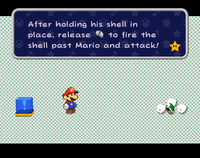
Switches make appearances in several parts of Paper Mario: The Thousand-Year Door, appearing as red or blue like the previous, as well as retaining its usual functionality of hitting blue switches once and red switches for an unlimited amount of time. Standard switches in this game are now cube-shaped. On rare occasions, they float in the air as blocks and must be jumped at to activate.
In Petal Meadows, Mario has to hit two blue switches with circular insides, called tandem switches (which appear after retrieving the two Stone Keys in Shhwonk Fortress), simultaneously to activate the Warp Pipe to Hooktail Castle; he accomplishes this by utilizing Koops's hold ability.
There are also black and white switches found in the Great Tree. Mario and company push the black switch to reveal four white switches in the room where Mario found the blue key to free the other Punies. Mario has to hit the white switches in this order: Sun, Moon, Puni, and Star to retrieve the Super Boots. Also in the Great Tree is a light-blue colored flat switch (simply called a "typical switch" by Goombella) which causes a standard blue switch to move underwater whenever it is depressed. Koops' hold ability again must be used to hit the switch when it comes back out.
A giant super switch appears outside the juice bar in Glitzville. Mario needs to perform a Spin Jump on it to activate it, allowing him to reach the roof. More super switches appear in Rogueport Underground, and cause blue pipes to appear when triggered.
Switches with numbers inside appear in the lower floors of the Riverside Station. Mario and friends have to defeat three Goombas guarding them to access them. The left switch has to be hit 3 times, the center switch has to be hit 10 times and the right switch only has to be hit once. Hitting the switches the correct amount of times will make them flash red until the last switch is hit. After all the switches are hit, the switches will vanish, opening a staircase leading Mario and friends to the Ultra Boots, as well as a Shine Sprite. Goombella cannot tattle these switches.
Seven red switches found in the Palace of Shadow are the only red switches that can only be used once. They move a wheel allowing Mario and his friends to get to the Shadow Queen's throne room and crypt. From left to right, hitting the first, third, fourth and sixth switches, as noted by the stars underneath the wheel, will activate it.
- Tattles
- "That's just a normal switch. Stomp on it or whack it to flip the switch."
- "That's a super switch. Do a Spin Jump above it to activate it."
- "That's a Lift Switch. Hit it to ride a Lift Block of the same color."
Super Paper Mario
Red and blue switches appear in Super Paper Mario similarly as before. Floating block versions are uncovered by the Pixl Fleep. A standard blue switch can be activated to spawn a giant red switch on the floor of Yold Ruins, causing Spiky Tromps to fall into a large pit and opening access to a door. Flopside similarly has one near a Heart Pillar. Switches changing between blue and pink appear in The Dotwood Tree, spawning platforms of the same color but removing those of the other color. Four switches in Floro Caverns change between black, white, blue, and red, and changing them is required to match nearby portraits of Floro Sapien royalty.
Super Mario-kun
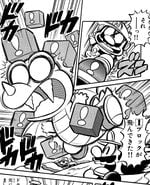
! Switches appear several times in Super Mario-kun. In one instance, the switch is used to defeat Rex. In another instance, a Reznor knocks Mario onto a building shaped like the ! Switch. After defeating the Reznor, Mario is shown to be exasperated at a set of invisible blocks, which require a ! Switch to activate.
Mario Pinball Land
Mario Pinball Land includes the Red Switch,[19]:23 found in every level, and the Blue Switch,[19] appearing in Grassy Greens Stage, the Bob-omb minigame within the blue Toad's tent, and in the boss fight against Bowser. Both types of switches give 3,000 points when activated. The Red Switch spawns eight Red Coins temporarily, but one can activate it again afterward until Mario gets a Star, turning the deactivated switch into a red ! Block with a Special Egg. The Blue Switch functions differently by location, including by making the windmill accessible in Grassy Greens Stage, making cannons shoot a Bob-omb if activated while flashing, and dropping Thwomps during the Bowser battle temporarily, obstructing him.
Mario Party 6
A non-functional green, a yellow, and a red ! Switch are displayed inside of Orb huts in Mario Party 6.
Super Princess Peach
Switches are found in the Fury Volcano stages and certain secret stages in Super Princess Peach. They can be activated while the Rage vibe is in effect. There are orange, floating, block-like switches that can turn on or off, and they appear blue in Wavy Beach.
Mario & Luigi: Bowser's Inside Story / Mario & Luigi: Bowser's Inside Story + Bowser Jr.'s Journey
There are many ! Switches in Mario & Luigi: Bowser's Inside Story and its remake. They can only be activated using Bowser's Body Slam attack. ! Switches are pink (red in the remake) and transparent but otherwise use their design from Super Mario 64. ! Switches have various effects, like opening doors or spawning platforms, then they become grayed, meaning they are no longer usable.
Yoshi's Woolly World / Poochy & Yoshi's Woolly World
Red and yellow ! Switches are in Yoshi's Woolly World and Poochy & Yoshi's Woolly World. The red ! Switches work the same as in the Yoshi's Island series. The yellow type, found only in Perils of the Perplexing Pyramid, works the opposite by turning yellow ! Blocks back into Dotted Line Blocks.
Super Smash Bros. Ultimate
Several red, blue, and yellow ! Switches appear in World of Light of Super Smash Bros. Ultimate, most prominently within the Molten Fortress. They cause ! Blocks to appear, creating functional bridges composed of ! Blocks.
Unused appearances
Paper Mario: Sticker Star
Blue ! Switches were intended to appear in Paper Mario: Sticker Star but were removed from the game.
Profiles
Yoshi's Island: Super Mario Advance 3
- Instruction booklet description:
- English (British):
Step on these to reveal hidden objects and cause other special things to happen.[page number needed]
- English (British):
Gallery
- For this subject's image gallery, see Gallery:! Switch.
A Purple Switch in the Hazy Maze Cave in Super Mario 64
A Purple Switch in Rainbow Ride
A sand-draining switch from Paper Mario
The Yellow Switch from Super Mario World: Super Mario Advance 2
The Purple Switch as it appears in Super Mario 64 DS
An unused checkpoint ! Switch from Super Mario Galaxy
The red ! Switch from New Super Mario Bros. Wii
The red ! Switch from New Super Mario Bros. 2
The yellow switch from Super Mario Run
Names in other languages
! Switch
| Language | Name | Meaning | Notes |
|---|---|---|---|
| Japanese | ビックリスイッチ[20] Bikkuri Suitchi |
Surprise Switch | Super Mario World, New Super Mario Bros. series |
| スイッチ[21][22][23][24][25][26] Suitchi |
Switch | ||
| [﹗]ボタン[27] [﹗] Botan |
[!] Button | Wario Land Advance | |
| スイッチブロック[28] Suitchi Burokku |
Switch Block | New Super Mario Bros., shared with P Switch and ? Switch | |
| Chinese | 开关[?] Kāiguān |
Switch | |
| French | Interrupteur ![?] | ! Switch | |
| German | !-Schalter[?] | ! Switch | |
| Italian | Interruttore ![?] | ! Switch | |
| Interruttore[29] | Switch | Super Mario 64 | |
| Portuguese | Interruptor ![?] | ! Switch | |
| Bloco de Mudança ![?] | ! Change Block | New Super Mario Bros. | |
| Russian | Переключатель[?] Pereklyuchatel' |
Switch |
Floor switch
| Language | Name | Meaning | Notes |
|---|---|---|---|
| Japanese | ゆかの スイッチ[25] Yuka no Suitchi |
Floor Switch |
Super switch
| Language | Name | Meaning | Notes |
|---|---|---|---|
| Japanese | スーパースイッチ[26] Sūpā Suitchi |
Super Switch | Paper Mario: The Thousand-Year Door |
| 大きいスイッチ[25] Ōkii Suitchi |
Big Switch | Paper Mario |
Blue Switch
| Language | Name | Meaning | Notes |
|---|---|---|---|
| Japanese | Ao Suitchi |
Blue Switch |
Red Switch
| Language | Name | Meaning | Notes |
|---|---|---|---|
| Japanese | Aka Suitchi |
Red Switch |
References
- ^ Bueno, Fernando (November 15, 2009). New Super Mario Bros. Wii: PRIMA Official Game Guide. Prima Games (American English). ISBN 978-0-307-46592-4. Page 67 and 171.
- ^ von Esmarch, Nick (2012). New Super Mario Bros. 2 PRIMA Official Game Guide. Prima Games (American English). ISBN 978-0-307-89552-3. Page 86, 87, 142, 168, 228.
- ^ Stratton, Steve (November 18, 2012). New Super Mario Bros. U PRIMA Official Game Guide. Prima Games (American English). ISBN 978-0-307-89690-2. Page 201.
- ^ Hodgson, David S J (October 21, 2003). Super Mario Advance 4: Super Mario Bros. 3 Prima's Official Strategy Guide. Prima Games (American English). ISBN 0-7615-4425-8. Page 122.
- ^ 2012. New Super Mario Bros. European instruction booklet (PDF). Nintendo of Europe (British English). Page 18.
- ^ Super Mario World English instruction booklet. Page 21.
- ^ September 1991. Nintendo Power Volume 28. Nintendo of America (American English). Page 14 and 22.
- ^ Jump up to: a b c d August 1991. Mario Mania Player's Guide. Nintendo of America (American English).
- ^ February 12, 2022. Yump. Super Mario World Speedrunning Wiki. Retrieved July 17, 2023. (Archived July 17, 2023, 23:25:45 UTC via Wayback Machine.)
- ^ 1996. Super Mario 64 Player's Guide. Nintendo of America (American English). Page 18.
- ^ "Bowser in the Dark World" Nintendo: Super Mario 64 Strategy. nintendo.com (American English). Archived February 24, 1998, 21:11:56 UTC from the original via Wayback Machine. Retrieved March 15, 2022.
- ^ 1995. Super Mario World 2: Yoshi's Island instruction booklet (PDF). Nintendo of America (American English). Page 17.
- ^ 2002. Yoshi's Island: Super Mario Advance 3 instruction booklet (PDF). Nintendo of Europe (British English). Page 11.
- ^ 2006. Yoshi's Island DS instruction booklet (PDF). Nintendo of Europe (British English). Page 17.
- ^ Yoshi's New Island digital manual (PDF). Page 13.
- ^ Get the second Star Piece. Nintendo: Super Mario RPG Strategy (American English). Archived February 24, 1998, 20:08:51 UTC from the original via Wayback Machine. Retrieved September 15, 2016.
- ^ 2001. Wario Land 4 instruction booklet. Nintendo of America (American English). Page 26.
- ^ Fall 2001. Nintendo Power Advance V.3. Nintendo Power (American English). Page 53.
- ^ Jump up to: a b 2004. Mario Pinball Land instruction booklet (PDF). Nintendo of America (American English). Page 23.
- ^ Sakai, Kazuya (Ambit) et al. (October 19, 2015). Super Mario Bros. Hyakka: Nintendo Kōshiki Guidebook. Shogakukan (Japanese). ISBN 978-4-09-106569-8. Page 61, 119, 151, 201, and 216.
- ^ Super Mario World Japanese instruction booklet, Switch Palace section (PDF). Nintendo (Japanese). Page 25.
- ^ 1995. Super Mario: Yossy Island instruction booklet (PDF). Nintendo (Japanese). Page 16.
- ^ 2006. ヨッシーアイランドDS (Yosshī Airando DS) instruction booklet (PDF). Nintendo (Japanese). Page 15.
- ^ 2014. Yoshi New Island digital manual (PDF). Nintendo (Japanese). Page 15.
- ^ Jump up to: a b c Tattle in Paper Mario
- ^ Jump up to: a b Tattle in Paper Mario: The Thousand-Year Door
- ^ 2001. Wario Land Advance Japanese instruction booklet. Nintendo (Japanese). Page 22.
- ^ 2006.
New スーパーマリオブラザーズ (Nyū Sūpā Mario Burazāzu) instruction booklet (PDF). Nintendo (Japanese). Page 17. - ^ November 15, 2018. Super Mario Bros. Enciclopedia. Magazzini Salani (Italian). ISBN 889367436X. Page 92.
- ^ 2004. Super Mario Ball instruction booklet (PDF). Nintendo (Japanese). Page 16.
- ^ 2004. Super Mario Ball instruction booklet (PDF). Nintendo (Japanese). Page 18.
| showLinks to related articles |
|---|
- Switches
- Mario Pinball Land objects
- New Super Luigi U objects
- New Super Mario Bros. objects
- New Super Mario Bros. 2 objects
- New Super Mario Bros. U objects
- New Super Mario Bros. Wii objects
- Paper Mario objects
- Paper Mario: The Thousand-Year Door objects
- Super Mario 64 objects
- Super Mario 64 DS objects
- Super Mario Advance 4: Super Mario Bros. 3 objects
- Super Mario Bros. Wonder objects
- Super Mario Run objects
- Super Mario World objects
- Super Mario World 2: Yoshi's Island objects
- Super Paper Mario objects
- Super Princess Peach objects
- Wario Land 4 objects
- Yoshi's Island DS objects
- Yoshi's Island: Super Mario Advance 3
- Yoshi's New Island objects
- Yoshi's Woolly World objects

